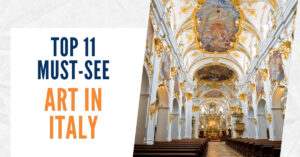The Vatican Museums stand as a treasure trove of art and history, housing ancient Roman sculptures, Renaissance masterpieces, and Egyptian artifacts. Each hall and corridor unfolds tales of faith, beauty, and human ingenuity, inviting visitors on a mesmerizing journey through centuries of cultural heritage. Here, the past is palpable, whispering stories from corners of the world frozen in time.
This incredible complex, a sanctum of history and spirituality, beckons art lovers, historians, and the curious alike. From the delicate brush strokes of the Renaissance to the grandeur of ancient Egyptian monuments, the Vatican Museums unfold a visual narrative of human civilization that is both profound and transcendent. Join us as we traverse this magnificent collection, where every artifact and masterpiece reveals a chapter of our collective legacy, inspiring awe and reflection.
History of the Vatican Museums
In the heart of 1506, Pope Julius II ignited the genesis of the Vatican Museums, anchoring a tradition that would flourish spectacularly in the annals of art and culture. His farsighted vision led to the inclusion of the Laocoön and His Sons, a masterpiece that heralded the museum’s establishment, embodying the Renaissance’s fervent admiration for antiquity. This initial act of preservation and celebration triggered an expansive era, with subsequent popes enriching this cultural bastion with works of unparalleled beauty and significance.
Each addition, from majestic tapestries to ethereal paintings, wove a richer narrative of Italian artistry, a testament to the nation’s profound influence on arts and humanities. The Vatican Museums, through these purposeful expansions, stand not merely as repositories of art but as vibrant vessels of Italian culture and history, safeguarding humanity’s collective heritage with unwavering dedication and showcasing it to the world with pride.
The Sistine Chapel: A Masterpiece of Artistic Triumph
The Sistine Chapel, an emblem of Renaissance creativity, stands as the Vatican Museums’ crown jewel. Michelangelo Buonarroti, in a formidable display of artistic genius, transformed its ceiling into a breathtaking canvas between 1508 and 1512. Commissioned by Pope Julius II, the ceiling’s intricate frescoes narrate the story of Creation, the Fall of Man, and the promise of Salvation, with the iconic ‘Creation of Adam’ capturing the human spirit’s essence. Later, from 1536 to 1541, Michelangelo returned to etch the ‘Last Judgment’ on the altar wall, a vivid portrayal of divine justice.
This revered sanctuary not only serves as the Pope’s private chapel but also as the solemn venue for the Papal Conclave. Its artistry and architecture, embodying the pinnacle of human achievement, draw millions, leaving an indelible mark of awe and inspiration. The Sistine Chapel, through its sublime beauty, connects the earthly to the divine, inviting all who enter to gaze upwards in wonder and contemplation.
Address: 00120 Vatican City
Opening Hours: Monday – Saturday (9 AM – 4 PM)
Phone: +39 06 6988 4676
The Pine Courtyard: An Oasis of Antiquity and Serenity
The Pine Courtyard, nestled within the Vatican Museums, stands as a peaceful retreat that beautifully showcases the marriage of nature with ancient and Renaissance sculptures. This open-air courtyard is named after the majestic bronze pinecone. It is originally part of Old St. Peter’s Basilica, dating back to the 1st century. The “Fontana della Pigna,” or Pinecone Fountain, presides over the courtyard, framed by lush Italian gardens and the impressive niches of the surrounding buildings.
In the 16th century, this tranquil space was thoughtfully designed to offer visitors and scholars alike a place of serene contemplation amidst the vast collections of art. The presence of the Belvedere Torso, a celebrated ancient marble sculpture greatly admired by Michelangelo and other Renaissance artists, emphasizes the courtyard’s role in bridging the awe-inspiring past with the creative spirit of the present. The Pine Courtyard continues to enchant visitors with its blend of natural beauty and historical significance, serving as a testament to the Vatican Museums’ enduring dedication to preserving and celebrating human creativity.
Address: 00120 Vatican City
Opening Hours: Monday – Saturday (8 AM – 6 PM)
The Pinacoteca: A Gallery of Timeless Masterpieces
The Pinacoteca, or Picture Gallery, within the Vatican Museums, is a sanctuary of Renaissance and Baroque artistry. It showcases an illustrious collection of paintings that span from the Middle Ages to the 19th century. Established by Pope Pius XI in 1932, the gallery was purpose-built to display the Vatican’s magnificent array of paintings. That is in an environment worthy of their splendor.
This careful curation allows visitors to embark on a chronological journey through the evolution of Christian art. This features seminal works by masters like Giotto, Raphael, and Caravaggio. The Pinacoteca’s galleries unfold a narrative of faith, human emotion, and divine beauty. Among its prized possessions, Raphael’s “Transfiguration” stands as a focal point. It embodies the pinnacle of Renaissance technique and spirituality. The Pinacoteca, through its storied halls, invites a deep communion with the past. This illuminates the profound link between art, history, and the human quest for transcendence.
Address: WF42+7WV, Viale Centro del Bosco, 00120 Città del Vaticano, Vatican City
For pictures and more information, click here.
Raphael’s Rooms: A Symphony of Art and Intellect
Raphael’s Rooms is known as the Stanze di Raffaello in the heart of the Vatican. They are an emblematic suite of four rooms adorned with frescoes that epitomize the Renaissance’s intellectual and artistic fervor. Commissioned by Pope Julius II in the early 16th century, and later Pope Leo X. These rooms were transformed by Raphael and his workshop into a visual narrative that marries theological wisdom with classical humanism.
Raphael’s inventive spirit is most vividly captured in the “School of Athens,”. A fresco that convenes the greatest minds of antiquity in an architectural marvel echoing the intellectual utopia of the period. Through his work, Raphael sought not just to decorate a space. He created environments that would inspire, educate, and reflect the pontiffs’ enlightened reign. Today, Raphael’s Rooms stand as a testament to the genius of their namesake. The enduring power of art to communicate across centuries invites visitors to wander through a Renaissance dreamscape of unparalleled beauty.
The Pio Clementino Museum: A Haven of Classical Antiquity
The Pio Clementino Museum stands as a crowning tribute to the majesty of classical antiquity. It brilliantly captures the essence of Greek and Roman artistry. Established by Pope Clement XIV in the late 18th century and subsequently expanded by Pope Pius VI. This museum was devised with a clear mission. That is to house and showcase the Vatican’s expanding collection of classical statues and artifacts.
The museum is ingeniously designed, leading visitors through a series of elaborately decorated halls and galleries. Each is dedicated to a different aspect of ancient culture and mythology. Highlights include the mesmerizing Laocoön Group, believed to have inspired the Vatican Museums’ foundation. The Belvedere Apollo, a paradigm of male beauty in ancient sculpture. The Pio Clementino Museum not only preserves these timeless treasures. It also celebrates the enduring influence of classical civilizations on Western culture.
Address: VA, Cdad. del Vaticano, 00120, Vatican City
Opening Hours: Monday – Saturday (8 AM – 7 PM)
Phone: +39 06 6988 4676
Conclusion
The Vatican Museums emerge not merely as a repository of art. But also as a beacon of human achievement and divine inspiration. From the ornate corridors of the Sistine Chapel to the classical antiquity preserved within the Pio Clementino Museum. Each space within the Vatican Museums is a testament to the labyrinthine journey of human creativity and spiritual quest. By weaving together the essence of Renaissance artistry, the profundity of religious narratives, and the timeless allure of ancient civilizations. These museums offer a unique lens through which to view the multifaceted story of humanity.
Visitors leave with not just memories of transcendent beauty and intellectual brilliance. A renewed sense of connection to the past and inspiration for the future. The Vatican Museums stand as an enduring symbol of culture’s power to transcend time. It narrates stories that continue to inspire awe, contemplation, and wonder.









